Durafly EFXtra Racer
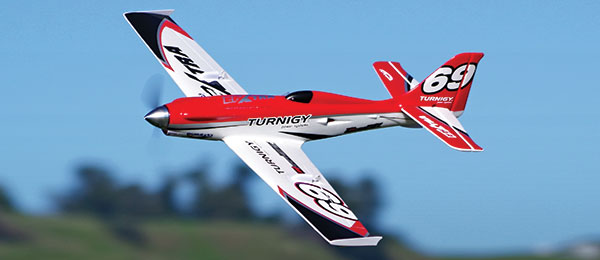
Written by Jon Barnes Satisfy your need for speed Product review As seen in the May 2017 issue of Model Aviation.
Bonus video
Specifications
Model type: PnF sport model speedster Skill level: Intermediate to advanced Wingspan: 38.4 inches Wing area: 215 square inches Length: 29.9 inches Weight: 23.7 ounces Power system: Brushless electric Radio system: Minimum four channels required Construction: EPO foam Street price: $136.30Test-Model Details
Motor used: AeroStar 3536-1780 Kv brushless outrunner ESC: 60-amp AeroStar with 5-amp BEC; XT60 connector Battery: Turnigy nano-tech 3S 11.1-volt 65C 2,200 mAh or 4S 14.8-volt 65C 1,800 mAh LiPo Propeller: 7 x 6.5 (4S) or 8 x 6 (3S) Radio system: OrangeRx T-SIX 2.4 GHz six-channel transmitter; OrangeRx R615X 2.4 GHz six-channel receiver Ready-to-fly weight: (4S) 30.6 ounces (3S); 30.8 ounces Flight duration: Four minutesPluses
• The EFXtra allows speed-hungry pilots to go fast without breaking the bank. • The EFXtra is capable of being flown on either a three- or four-cell battery with only a required propeller change, allowing pilots of various skill levels to progressively acclimate to this model’s high-performance flight envelope. • The use of ball-link-style connectors on all control surfaces minimizes pushrod backlash and makes for precise pushrod positioning and performance. • The included FPV canopy allows enthusiasts to climb aboard for a triple-digit, high-speed thrill ride. • A variety of battery sizes can effectively be used in this model, although the narrow fuselage might disallow irregular-shaped packs from being used.Minuses
• The 3mm gap between the spinner backplate and fuselage is somewhat wide. • The battery hatch is a slightly different shade of red than the rest of the fuselage.Product Review
You cannot begin a review of the Durafly EFXtra—an exciting, high-performance, foam composition speedster—without a short digression to the autumn 2014 release of the original Durafly EFX Racer. Most of the Durafly models that were released before the EFX Racer were solidly based on scale aircraft. Many pilots were surprised to see a sleek and stylish model with an obvious race-bred pedigree suddenly emerge from the Durafly design hangar. The EFX Racer was originally available in red or yellow color schemes, both of which featured a thorough slathering of HobbyKing- and Durafly-associated product brands and logos. The model featured a versatile and powerful brushless power system, designed to be capable of using either a three-cell or four-cell LiPo battery with nothing more than a propeller change required. The EFX Racer’s performance, when flown on four cells, allowed it to break the triple-digit speed barrier. With a relatively short production run, however, potential EFX pilots who were late to the party found it difficult, if not impossible, to lay their hands upon this exciting and affordable high-performance, foam-composition racer. Enter the EFXtra. Durafly’s release of a second-generation version of the EFX Racer allows those who missed the first go-around to not only party hearty, but also enjoy several subtle tweaks and improvements to the original design. The first and most obvious alteration to the original model is the clipped dimensions of the EFXtra’s main wing. Although the original model spanned 43 inches, the EFXtra comes in at a svelte (and potentially speedier) 38.4 inches. Another speed-friendly enhancement to the EFXtra is its use of a hotter brushless motor and ESC with a higher current rating. While the original EFX Racer came equipped with a 2836-2300 Kv motor and 50-amp ESC, the EFXtra is powered by an AeroStar 3536-1780 Kv motor and 60-amp ESC. Durafly adds a little bling to the nose of the EFXtra in the form of a polished aluminum spinner—a definite upgrade over the plastic spinner used on previous versions. The EFXtra retains the ability to run on either a three- or four-cell LiPo battery, with propellers for both cell counts included in the box. Other notable enhancements to the 2.0 version of this speedster are the inclusion of a laser-cut plywood and polycarbonate FPV hatch and a polycarbonate nose cone that allows the EFXtra to be transformed into a Slope Soaring sailplane. Additionally, Durafly is reported to have increased the overall size of the battery compartment on the EFXtra. This should permit pilots to use a greater variety of batteries and even shoehorn in higher-capacity (read as longer flight duration) packs.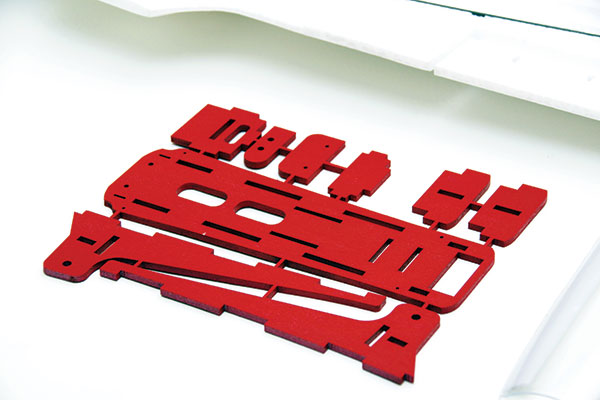
The light plywood FPV camera mount is laser cut and prepainted to match the color of the airframe. Assembly is required.
Durafly retains the same HobbyKing product-based advertising graphics scheme, but allows pilots to choose between a red, green, or blue airframe. To complete this kit, pilots are required to provide a minimum four-channel radio system and either a three-cell 2,200 to 2,700 mAh or four-cell 1,800 to 2,400 mAh high C-rated LiPo battery.
Construction
As a Plug and Fly (PnF) kit, the EFXtra arrives with all electronics factory installed. Pilots need only assemble the airframe, install a receiver, and program a new model into the transmitter. The red EFXtra is mostly white on its underside, which should offer pilots meaningful and invaluable inflight orientation cues. The horizontal stabilizer/elevator halves uniquely assemble without any fasteners. Align the two pieces through the slot in the fuselage and push them together until they lock into place. The plastic clips used to secure them fit tightly and require a fair amount of force to get them to lock together. Pilots who prefer additional peace of mind can supplement this engineered mechanical retention method with a bit of adhesive if desired. The best safety practices dictate that a pilot should refrain from installing one of the two included propellers until all transmitter programming and control surface setups have been completed. Durafly’s use of ball-link-style connectors on the control surface end of the pushrods minimizes mechanical backlash. A pair of ball-link pliers is invaluable when you are making the initial adjustments to the neutral positions of the aileron pushrods. EZ link-style connectors on the servo horn ends of the elevator and rudder pushrods make for easy adjustment of these two quadrants. Pilots will want to carefully apply a drop or two of threadlocker compound to the EZ link setscrews after the neutral positions have been set. The relatively narrow fuselage dimensions will require that pilots carefully stow their choice of receiver and servo wiring between and slightly aft of the rudder and elevator servos. The space forward of the two servos is reserved for the flight battery. A chic-looking, blue Durafly hook-and-loop strap is preinstalled in the battery bay, although pilots might wish to augment its holding power with a small piece of surface-mounted, adhesive-backed hook-and-loop material for maximum battery retention security.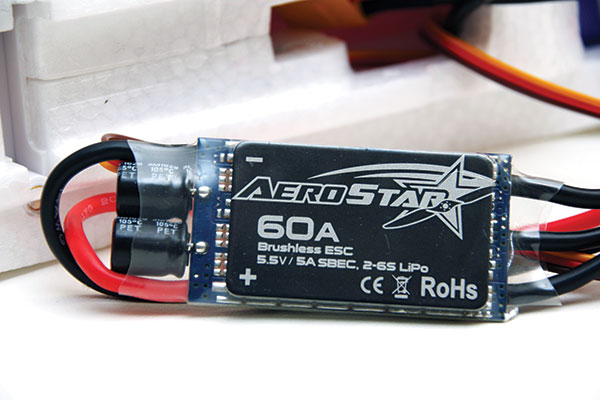
The included AeroStar 60-amp ESC will capably cover flight operations on three- and four-cell batteries. Pilots wishing to explore the speed of a six-cell setup will need to source an ESC with a higher amp rating.
Because all EFXtra flights will end with a belly landing, Durafly positioned the aileron pushrods on the top side of the wing. A thick, adhesive strip-backed, clear polycarbonate skid plate is designed to protect the underside of the fuselage and runs from the leading edge of the wing forward to the nose of the airplane. A white plastic skeg is factory mounted at the aft end of the fuselage, with a long teardrop-shaped polycarbonate landing skid mounted on the centerline of the fuselage/wing as the primary landing skid. White plastic end caps located at the wingtips do double duty as landing skids and general purpose wingtip protectors. The variety of protective pieces shows that Durafly designed the EFXtra to capably endure the rigors and stresses inherent to repeatedly belly landing a model! The included polished-aluminum spinner nicely crowns the nose of this colorfully crafted airframe, although the size of the gap between the spinner backplate and front of the fuselage (3mm) could provide aesthetics-focused pilots with a moment or two of consternation.
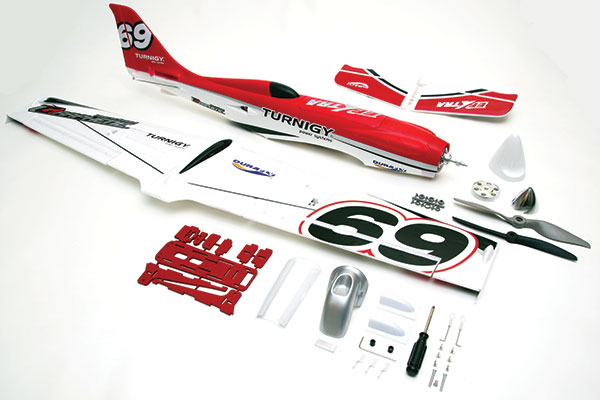
Notable extras in this kit include a polished aluminum spinner, a slope soaring nose cone blank, an FPV camera mount, and a canopy fairing.
The included laser-cut, light plywood FPV canopy arrives painted to match the airframe base color. Pilots will need to assemble this component and mount their choice of camera, video transmitter, and antenna to it when complete. The included silver polycarbonate fairing helps to streamline the FPV canopy assembly and prevent it from taking too much off the top speed of this sleek racing airframe.
Flying
The first step in getting the EFXtra party started is hand launching this landing gear-free model. Pilots unaccustomed to hand launching a low-wing, tractor propeller-configured model need not feel anxious. With an abundance of power on tap, launching the EFXtra couldn’t be easier! With a freshly charged Turnigy nano-tech A-SPEC 3S 2,200 mAh LiPo battery pack in the EFXtra, the power system is good for approximately 525 watts at wide-open throttle (a sustained, 15-second full-throttle static test that was performed using an Eagle Tree eLogger data logging system). Switch to a 4S LiPo battery pack and the watts jump by approximately 100. A successful hand-launching technique involves attention to a few common-sense details. As the manual suggests, the best way to launch a low-wing model such as the EFXtra is by using an underhand grip. Grasp the model near the center of gravity (CG), run the throttle to 60% or 70%, and give it a smooth, underhand arcing toss. Hand launchers should visualize a release angle of 30° to 40° and make sure that they follow through in their launching motion. Pilots who fly mode two might find that launching left handed is preferable, given that it allows them to immediately use their right hand to provide any needed corrective aileron/elevator inputs. Although attempting an overhand grip-style launch could buy a pilot a few extra feet of release altitude, it is impossible to grip the EFXtra near its CG when grasping it from below. This can make for an inherently tricky and awkward hand launch.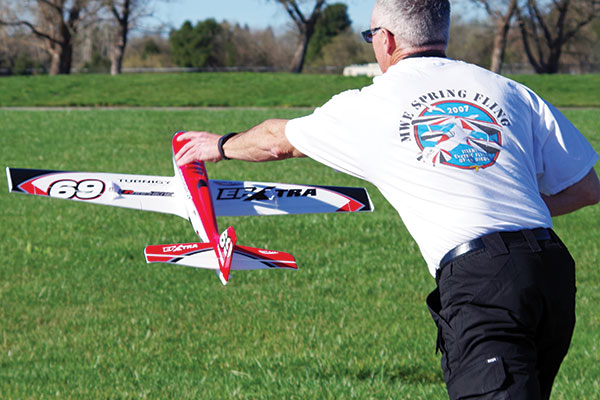
Best practices for successful hand launches involve an underhand release, with the EFXtra gripped near the CG at roughly 60% to 70% throttle.
Pilots who find themselves apprehensive about the first hand launches of their EFXtra might want to employ a capable assistant. This decision comes with the caveat that the selected assistant has an established and proven reputation as a capable hand launcher. With the EFXtra in the air and on step, pilots will find that this model can become small quite fast. Even at reduced power settings, it retains energy well and can climb vertically with a vengeance. Sport-style aerobatics, including aileron rolls and loops, are fast and furious when performed on high rates. Top speeds using a strong, high C-rated three-cell 2,200 mAh LiPo battery and the included 8 x 6 propeller are easily in the range of 90 mph. Switching to the 7 x 6.5 propeller and an 1,800 mAh four-cell LiPo pack allows the EFXtra to easily punch through the 100 mph speed barrier! Whether a pilot chooses to fly the EFXtra on three- or four-cell batteries, the model exhibits impressive and precise in-flight tracking. Much of this is owing to the tight, zero-slop linkages created by Durafly’s use of ball-link connectors on the pushrods. With the throttle pegged and left at full, this model can be mercilessly yanked and banked around the skies. Durafly is reported to have increased the amount of composite and carbon-fiber reinforcing used throughout the airframe. Its ability to endure a sustained full-throttle torture test, with repeated oval circuits made using full up-elevator in the corners, is a testimony to its rigidity and reinforcement. Although this model is sure to log most of its in-flight hours at full throttle, pilots shouldn’t worry when it is time to transition into the landing pattern. The EFXtra’s high-speed capabilities do not in any way come at the expense of slow-speed stability and benign behavior. Pilots will find that this model will quite predictably cruise around the pattern at substantially reduced throttle settings. With the throttle completely pulled to the off position, the EFXtra will slide smoothly down the glide slope on final approach. Pilots will probably require several landing approaches before they manage to land the EFXtra where they want. The airframe jealously hangs onto every last bit of forward momentum and will linger in ground effect for an amazingly long period before dropping to the runway surface. All of this is from an EPO foam-composition model!
Conclusion
Pilots hungry to taste the thrill of speed often find themselves moving toward potentially wallet-taxing composite airframes. The EFXtra is a turnkey and affordable foam-composition speedster with which a pilot can progressively explore high-speed flight. This second-generation version offers a lot of extras when compared with its predecessor: extra speed and performance thanks to a hotter power system; extra choices of three color schemes; extra space for slightly larger battery packs; and extra included options that allow it to be used as an FPV platform or Slope Soaring sailplane.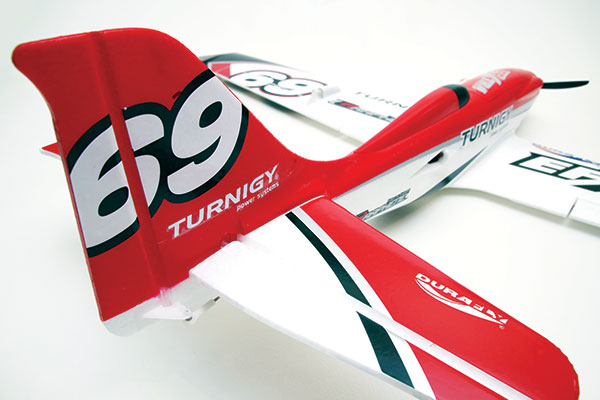
Durafly offers the EFXtra in red, blue, and green color schemes, all of which feature racy-looking, stock car-reminiscent graphics.
Should a pilot’s desire for speed not be satisfied by flying the EFXtra on four cells, Durafly mentions in the assembly manual that the brushless motor used in this model can be safely flown with a 5 x 5 propeller for flights with six-cell batteries. Pilots will, however, need to source an 80-amp ESC for this option. Configure and fly the Durafly EFXtra on a three-cell battery pack and it can be flown as tamely as a sport model. Reconfiguring it to use a four-cell or even six-cell battery pack fully unleashes its design potential, allowing it to fly like the insane triple-digit, aerobatics-capable speedster that it is. —Jon Barnes [email protected]










2 comments
Got my EFXtra into the air
Nice plane to have, but..
Add new comment